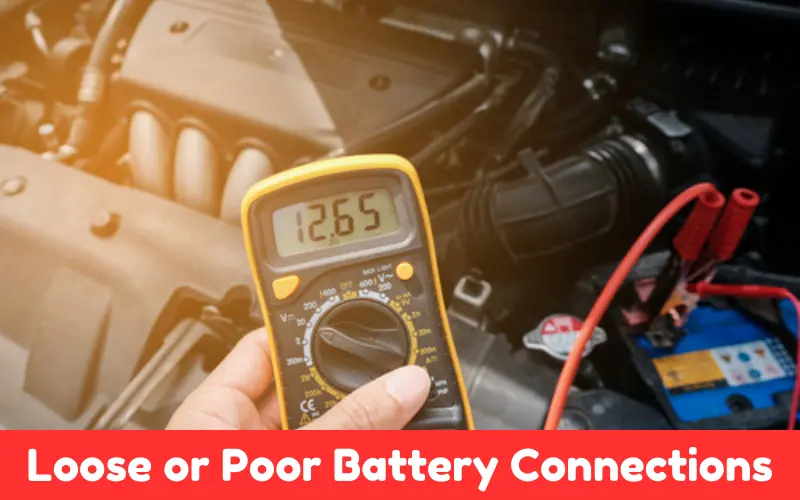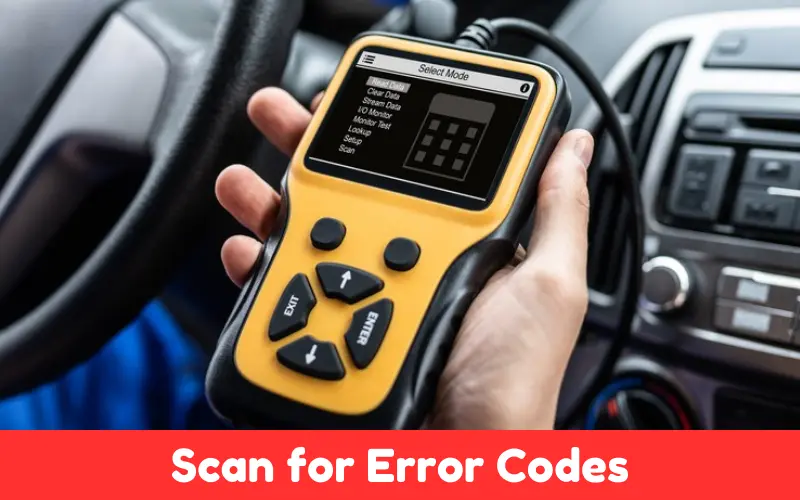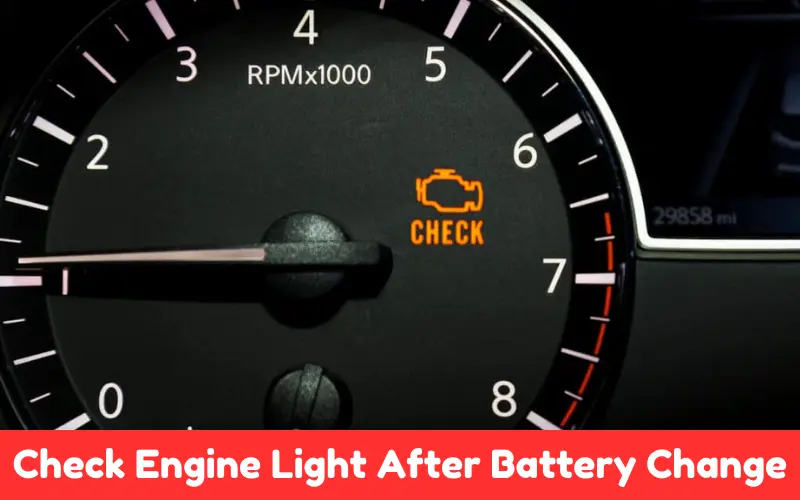Changing your car battery can be simple, but it can sometimes cause the dreaded check engine light to show up. You may try everything to get your check engine light off through a mechanic. It’s not as bad as it seems.
Here’s a complete guide to what causes a check engine light after battery change and what you can do about it.
Article Summary
- Can A New Battery Cause Check Engine Light To Come On?
- Causes of Check Engine Light After Battery Change
- How To Reset Check Engine Light After Battery Change
- How To Prevent Check Engine Light After Battery Replacement
- FAQs On Check Engine Light After Battery Change
- Why Did Check Engine Light Come On After Changing the Battery?
- How Can I Reset the Check Engine Light After A Battery Change?
- Is It Safe to Drive If the Check Engine Light is On?
- Can A loose Battery Connection Cause the Check Engine Light To Come On?
- Should I Use An OBD-II Scanner To Diagnose the Problem?
- Conclusion
Can A New Battery Cause Check Engine Light To Come On?
Yes, a new battery is frequently thought to be the culprit, and rightly so.
The light is typically affected because a battery change causes a restart of the Engine Control Module (ECM) that manages engine performance and emissions.
Because of this, the ECM can lose the memory of its stored settings and cycle through a calibration process, resulting in a check engine light flashing as it clears the way for a redownload of stored data.
Also, there can be abnormal electrical signals if the battery connections aren’t tight and corroded or if the media contacts have sediment build-up.
And yes, the sensors involved the oxygen (‘O2’) sensor and the mass airflow (MAF) sensor could be sending a confused ‘ground’ to the ECM during a battery change, causing the computer to flag an error.
These things must be a concern, but another scenario is just as likely. Perhaps the calibration just needs time to resettle perhaps the oxygen or MAF sensors were bumped while the old battery was removed (causing a freakishly random alert); perhaps you reset the computer by mistakenly hitting the light with your fist.
If the light goes on shortly after that (and it never flickered before), then the sensor might still be resetting. Whatever the case, go through what has happened, and then back it down most of the way and check the connections.
If that doesn’t work, then reset the battery, wait 10 minutes, and see if the light changes. Or just accept that a new battery might startle a vehicle’s electronic brain and let it cycle its way through to a new, proper setting.
However, if for no other reason than the nagging annoyance of seeing the light, do yourself the favor of checking with an OBD-II scanner if it hangs there for several hours. Never bother with this stuff and call a professional mechanic.
Causes of Check Engine Light After Battery Change
After changing battery check engine light sign can come on your vehicle’s dashboard. It’s not a matter of surprising. There are some causes behind the issue. they are given below:
1. Temporary Reset of Engine Control Module (ECM)
When you replace the battery, the ECM (Engine Control Module) loses its stored memory, in this case, the data for managing your car’s engine performance and emissions.
A reset ECM can cause the check engine light to come on until it recalibrates or relearns your car’s best settings or until it falls victim to another call for a reset.
2. Loose or Poor Battery Connections
When changing the battery, the connections to the battery terminals aren’t tight and clean. Poor connections can lead to erratic electrical signals, which can set off the malfunction indicator light.

3. Corrupted ECM Data
Other times, however, the ECM gets corrupted during the battery change, throwing an error and turning on the check engine light.
4. Sensor Issues
Your car might have many sensors e.g. oxygen sensor, mass airflow sensor, etc. that can produce erratic signals to the engine control module (ECM) during the battery replacement, turning on the check engine light.
How To Reset Check Engine Light After Battery Change
Following the steps will help you resolve this problem and enjoy the sound of your engine while your car is running.
Check the Battery Connections
Check that the battery terminals are tight and not corroded. Loose connections can lead to many electrical problems.
Reset Engine Control Module (ECM)
On occasion, removing the battery for a couple of minutes and then reconnecting it will reset the check engine light spark. This gives the ECM a chance to think through and recover from a minor programming error.
Drive The Car
If the light stays on after checking the connections and resetting the ECM, drive a few miles. The ECM might need to reset and relearn the vehicle’s parameters.
Scan for Error Codes
Get the error codes from the ECM by using an OBD-II scanner.

The car usually stores a couple of codes specific to the problem that is causing the check engine light to malfunction. Many auto parts stores still have a free OBD-II scanner that you can use.
Seek Professional Help
If your ‘check engine’ light comes on and doesn’t return to normal and you can’t find the problem yourself, you need to have a professional mechanic perform a diagnostic on your car.
How To Prevent Check Engine Light After Battery Replacement
The following preventive measures can protect your vehicle from the issue.
Maintain Your Battery: If you use your laptop frequently, inspect its battery at least once a month and keep it charged. Wipe the terminals clean and make sure they are bolted down tightly.
Avoid Electrical Drains: It’s a good idea to switch off the car’s electrical parts when you don’t use it so that the battery doesn’t discharge.
Regular Maintenance: Here is your schedule for preventive maintenance for your vehicle: Run the entire work; test the ECM and the sensors.
There are various reasons for the light staying on after a battery change, which I discussed above, and sometimes accompanied by a funny engine cap. These are usually minor problems that can easily be resolved, nothing usually serious.
In conclusion, changing batteries at home or in the garage is a good idea as they tend to be cheaper than in the dealer, though sometimes costly due to packaging material that needs to be collected and returned by users.
FAQs On Check Engine Light After Battery Change
Why Did Check Engine Light Come On After Changing the Battery?
The onset of the check engine light could be due to a low memory condition in the ECM, loose or weak battery connections, corrupted ECM data, or faulty sensors sending the ECM erroneous signals at the time of the battery change or switchover.
How Can I Reset the Check Engine Light After A Battery Change?
In fact, disconnecting and reconnecting the battery for a few minutes can force the ECM to reset and clear minor errors that have appeared. At a minimum, driving the car a few miles could help the ECM reset and, in turn, shut off the check engine light.
Is It Safe to Drive If the Check Engine Light is On?
In most cases, and unless the car’s drivability has changed significantly braking problems, strange noises, poor fuel efficiency, etc. you can continue using the car after changing the battery even if the check engine light appears.
Can A loose Battery Connection Cause the Check Engine Light To Come On?
Absolutely a loose or bad battery ground will result in intermittent electrical signals that could trip a flag within the ECM. A preliminary step is to check to make sure your battery terminals are secure and free from corrosion.
Should I Use An OBD-II Scanner To Diagnose the Problem?
Bluetooth OBD-II scanners are a great tool. Hook them up to your car to read the error codes from the ECM and find out exactly what is causing your check engine light to come on. Many auto parts stores will scan your car for free, or you can purchase your scanner.
Conclusion
A check engine light on after a car battery change can be intimidating, though it may be more of a minor, easily addressed problem. Make sure the battery terminals are correctly connected, reset the Engine Control Module (ECM), and then let the car run for a bit while it recalibrates itself.
Most likely, this will clear the light and put everything back in order. If not, call a mechanic, or even better, be more proactive with routine maintenance and battery care to prevent it from happening again.
Keeping that check engine light turned off will go a long way toward ensuring your car keeps on running.

